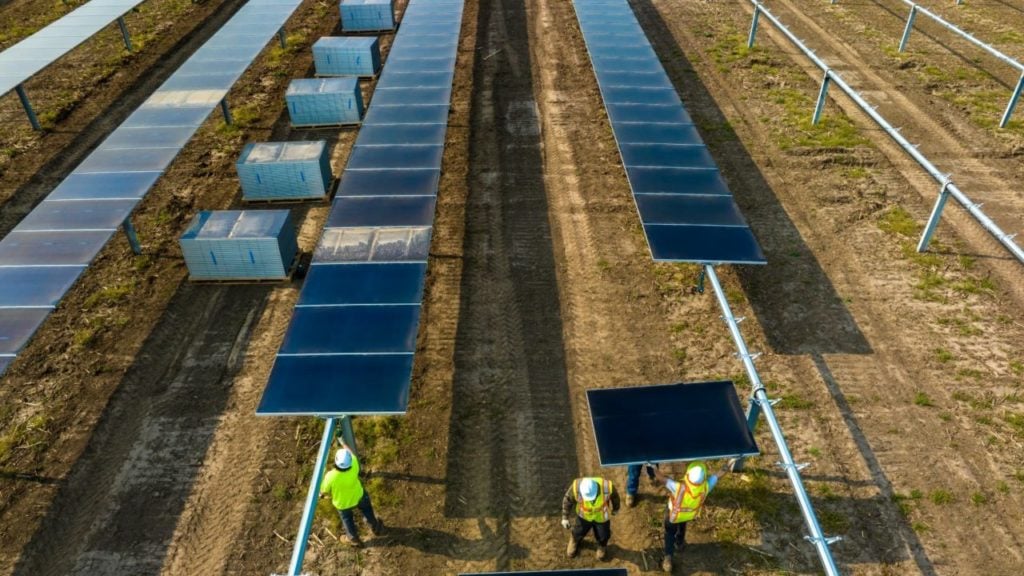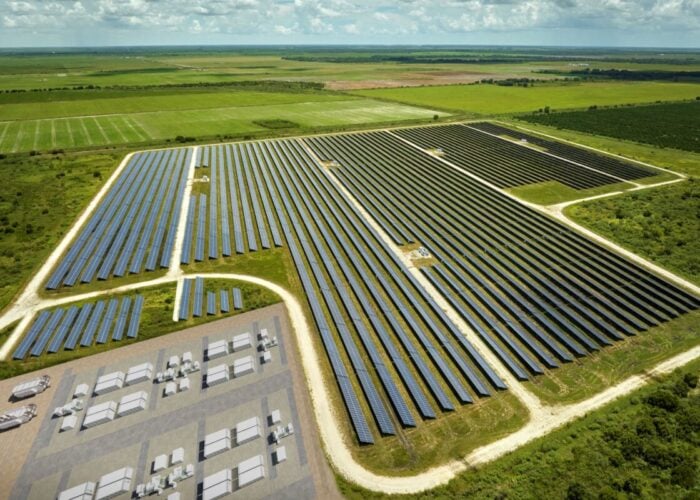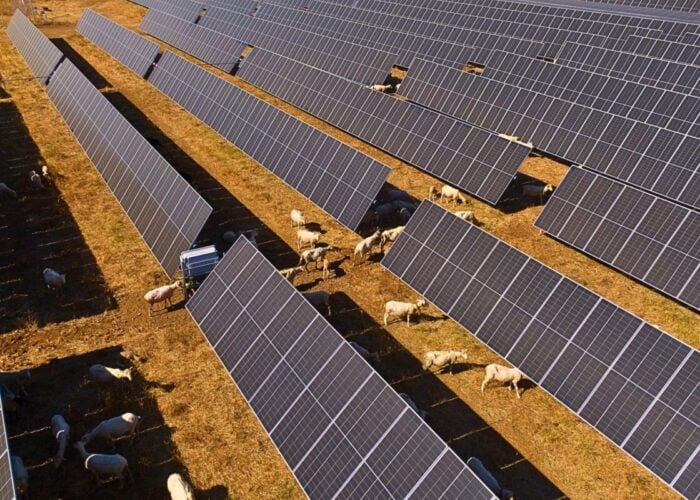
Following PV Tech Premium’s discussion of the “incredible” levels of finance now available in the solar sector, an increasing volume of finance is coming from so-called ‘green bonds’.
“[The green bond] was US$2 billion in 2010,” Meggie Eloy, a senior analyst at the Climate Bonds Initiative (CBI), tells PV Tech Premium, discussing the growth in the global clean bonds sector. “Last year, it was US$4 trillion, so it’s still growing and we’re seeing annually that green bonds are massively expanding, so it’s a market that’s very quickly growing. And I would say a large part of that is because of us and the work that we’re doing within solar in particular.”
Unlock unlimited access for 12 whole months of distinctive global analysis
Photovoltaics International is now included.
- Regular insight and analysis of the industry’s biggest developments
- In-depth interviews with the industry’s leading figures
- Unlimited digital access to the PV Tech Power journal catalogue
- Unlimited digital access to the Photovoltaics International journal catalogue
- Access to more than 1,000 technical papers
- Discounts on Solar Media’s portfolio of events, in-person and virtual
The Climate Bonds Initiative (CBI) works to verify the green credentials of investments, by assessing the scope and intent of bonds for power projects against its own criteria for ‘green’ investment. The initiative defines green bonds as financial commitments into the renewables space, and provides accreditation for these arrangements, to improve the reputation of the companies involved in the bonds, and to help them attract greater interest from other clean energy investors.
“We’re essentially saying: ‘If you want to issue something green, we’ll support you, we’ll connect you to investors, we’re happy to do that, but we’re going to tell you what green should look like,’” says Eloy.
Real-world examples
The use of green bonds has no shortage of benefits for investors, not least the reputational benefits of being seen to be involved in the energy transition, and Eloy suggests that the role of the CBI has become that of “middlemen,” seeking to connect investors to developers, both of which are keen to demonstrate their environmental commitments.
“We hold a green bond database, where anything that people label as being green in the market, we’re screening and measuring that against that criteria to make sure it’s actually green,” Eloy adds, highlighting the high standards to which investors seeking to categorise their bonds as ‘green’ are held. “If it’s not green enough, we won’t include it, there’s no two ways about it. We’re not making leeway at all.”
According to the CBI’s own figures, the value of green bonds reached US$4.2 trillion by the third quarter of 2023. Of this, US$2.6 trillion was spent on ‘green’ investments, including those related to clean power generation, accounting for 62% of all investments made. The remaining money was split between social projects, which accounted for 19%, sustainability projects, which accounted for 18%, sustainability-linked benefits, which accounted for 1%, and energy transition projects, which accounted for 0.3%.
These projects include ACWA Power’s securing of a US$2.2 billion loan to support its development of the Al-Shuaibah 1 and 2 solar plants, a huge portfolio with a combined solar capacity of 2.6GW. These projects are expected to reach commercial operation in 2025, and are a clear example of the work that a green bond can do to facilitate large-scale solar deployment.
Elsewhere, French utility Engie is investing US$1.5 billion into green hydrogen production, with the hydrogen produced by electricity sourced exclusively from wind and solar projects, demonstrating how the CBI has become involved in technologies and processes adjacent to the solar sector, such as hydrogen production.
The CBI has acknowledged both of these initiatives as suitably green to meet its standards, and its ongoing work in verifying green bonds is particularly significant considering the vast sums of money now entering the solar sector. Bloomberg New Energy Finance (BNEF) reporting earlier this year that the renewables sector saw a record US$1.8 trillion in investment in 2023.
Working together to meet targets
However, there is still work to do in terms of scaling up the green investments to meet the world’s climate change goals. Sean Kidney, CEO of the CBI, said in August 2023, that green bonds will need to become a US$5 trillion-per-year proposition in the coming years.
“We’re well into a crucial decade for the climate action and if we don’t slash emissions by 2030, our planet’s ecosystems will start to derail,” said Kidney. “Though sustainable finance is on its way to being a US$5 trillion market, we need to see US$5 trillion of sustainable finance being raised annually in the latter half of the decade, to prevent future climate collapse.”
The CBI has suggested previously that greater government involvement could help facilitate this scaling up. It has pointed to the example of the Moroccan government providing a guarantee for the country’s first green bond, issues by the Moroccan Agency for Sustainable Energy in 2017, to help mitigate some of the risk that investors may perceive in clean power projects.
“When we started, the whole thing was about bonds, but we’ve definitely expanded to work with governments now … to look at policy, so it’s very much beyond the financial instrument side,” says Eloy, who goes on to suggest that a close relationship between renewable power developers and the CBI could be crucial to realising climate goals.
“How do you actually write a transition framework?” Eloy asks. “It’s looking at ‘okay, you have a target to reduce your emissions by x amount by next year,’ great, have that target, make it public, so there’s more pressure on you to do something, but the conversation doesn’t stop there. I think that’s where the conversation has stopped a lot and then who’s accountable for that?”
“[The CBI is] telling you: you need to now say how you’re going to do that, and you also need to have interim targets, in the short term, in five years. Annually, how are you going to report to make sure that you’re being held accountable for this, and you’re reporting on progress and keeping your investors updated on what’s going on?”
Ensuring transparency
As more companies become involved in the green bonds space, the CBI’s role has shifted, from simply connecting one organisation to another to ensuring high standards of sustainability compliance across these deals. As a global organisation, the CBI is perhaps uniquely positioned to not just facilitate these deals, but set the standard for what sustainable finance could look like.
“With solar the key thing for us is [definition],” says Eloy. “If you’re going to have a financial instrument in this sector, what does best practice look like? We want transparency, we want you to know how to report on your emissions, but also how to report on any backup electricity usage.”
This latter point is particularly significant for Eloy, who gives the example of a power plant using both solar and fossil fuels to generate electricity, with the latter serving as a backup for the more variable solar power.
While total investment in renewables has long exceeded that of fossil fuels – according to the International Energy Agency (IEA), renewable investments first overtook fossil fuels in 2018, and in 2023, the world invested just over US$1 trillion for fossil fuels, almost half of that which was committed to renewables – the combination of renewable and dispatchable power is common in many power grids, and the CBI is eager to reflect these nuances in its work.
“For us, we’ve defined that as you can have a fossil fuel backup, but it needs to be less than 15% of the overall energy generation,” explains Eloy. “What we’ve been doing in the solar space for an already green sector[is] making sure that it can be as green as possible and that’s through being transparent with your reporting.”
Limiting factors beyond capital
For organisations such as the CBI, the emphasis is on ensuring fair and transparent reporting standards, in an industry where there is already considerable interest in making investments that are sustainable from an environmental perspective.
However, looking at the separate components of environmental, social and governance (ESG) compliance is challenging, and ideas of transparency and openness fall under the remits of the latter two aspects, which Eloy argues are much harder to express than the relatively simple figures of carbon emission mitigation.
“At the CBI we’ve always looked at the ‘e’ part, it’s always been about the environment,” says Eloy, “because it’s very easily measured in emissions or in a particular system within that industry or process. We’re trying to look at the social side because we’re now doing some work on social and sustainability bonds.
“We do have a methodology of how we would define what a green social and sustainability bond looks like. I have a colleague who’s directly working on that [but] it’s a bit harder to measure because yes, you can have things like gender equality or fair pay, but then when you’re actually looking at people it’s so much more complex in that there can’t be quantitative data, it has to be qualitative, if you really want to look at it properly.”
Fighting greenwashing
Eloy also suggests that there is a need to better educate those across the financing space about the nature of sustainable finance, and how best capital can be deployed in a way to comply with all the components of ESG. Eloy notes that: “the biggest thing is [green bonds are] an education piece,” and stresses that the CBI’s work takes into account the nuances of working in what can be a complicated sector.
“We do have a ‘flexibility pocket’, so there’s a 10% pocket of the instrument [that] can be towards criteria that we don’t have,” says Eloy. “For example, let’s say nuclear; we don’t have criteria for nuclear, so we haven’t set out what best practice for nuclear looks like.
“Then, if [the nuclear project] was less than 10% of the overall financing structure, we would allow that [to be considered a green bond] but we have safeguards on that; that doesn’t mean that that 10% pocket can be for anything.”
Eloy goes on to note that projects that focus primarily on fossil fuel generation and deforestation will be excluded from involvement in green bonds, as the CBI looks to balance the need for flexibility with maintenance of high standards of what is considered a sustainable investment. While that could refer to simply environmentally-friendly projects, or those that look to improve the lives of the humans involved in them, Eloy argues that the fundamental purpose of a green bond is to combat greenwashing, and that the CBI is well-placed to do just that.
“The biggest thing for us is to fight greenwashing,” concludes Eloy. “A green bond is essentially a tool to fight greenwashing.”







